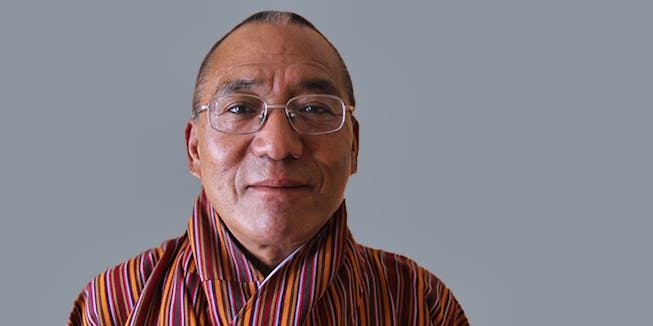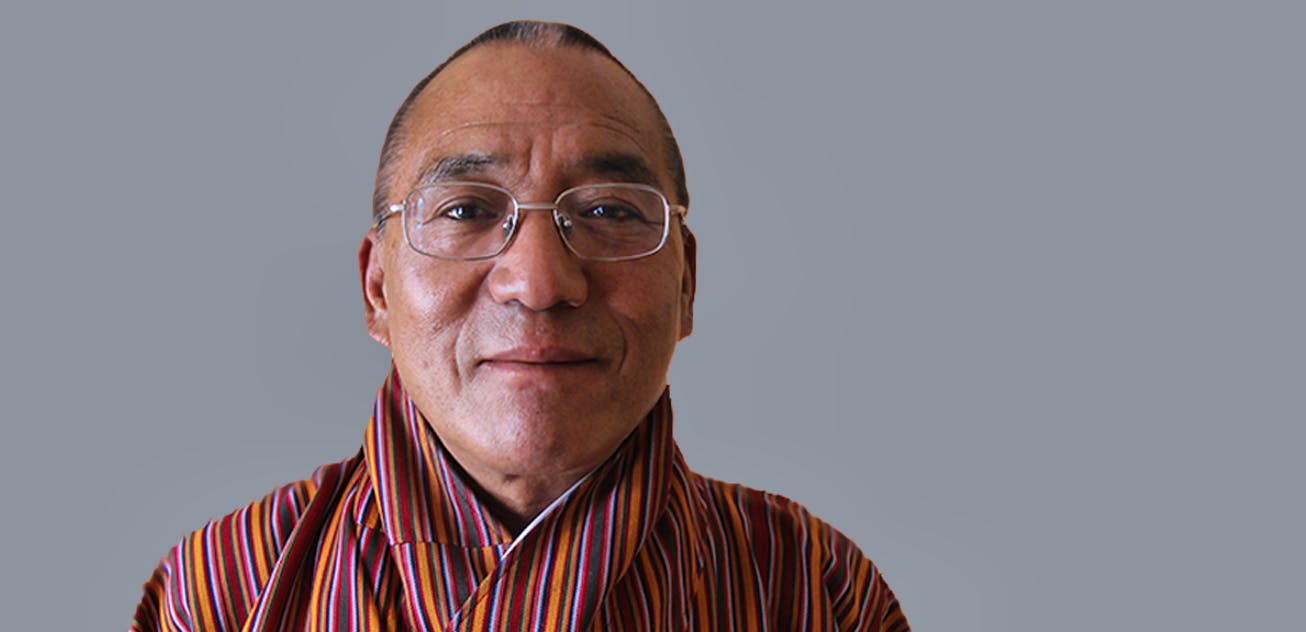Tandi Wangchuk, Drukair
«At Drukair, we are planning to convert an Airbus A319 into a freighter»
Tandi Wangchuk is the CEO of Drukair. In this interview, he speaks about how the Bhutanese national airline survived the pandemic, that it is converting an Airbus 319 into a freighter, and why his airline is drawn to Dubai.

Tandi Wangchuk: «Although they could, foreign competitors don’t want to fly to Bhutan because it is simply too difficult.»

Tandi Wangchuk: «Although they could, foreign competitors don’t want to fly to Bhutan because it is simply too difficult.»
Bhutan’s king has introduced Gross National Happiness as a measure of the collective well-being of the population. What role does Drukair play in this concept?
Tandi Wangchuk: Bhutan is a small landlocked country that lies between two very large states, China and India. Security and self-reliance are therefore very important for us – and also a prerequisite for happiness. Drukair provides connectivity and brings independence from neighboring countries. After all, the only alternative to air travel is the road to neighboring countries. Moreover, tourism is the second most important source of income for Bhutan. And happiness can only be created if the people are doing well economically. Drukair makes sure that tourists from all over the world can come to our country. Last but not least, religion is very important for our people. And we fly them to other religious sites in the region.
The airline industry has just gone through a long pandemic. How has that affected your airline?
We had very big plans for 2020. The well-known travel guide Lonely Planet had named Bhutan a top destination. We therefore geared up for strong growth and expanded the fleet accordingly. In March, we took delivery of an Airbus A320 Neo – and then the pandemic struck. What helped us during the crisis was that we were a state-owned company. We had the support of the government.
Did you have to cut jobs?
We were the first in Bhutan to agree to voluntary wage cuts, which were up to 25 percent for the highest earners. Our pilots have the highest wages because otherwise we would lose them to foreign competitors. They also went along with this. In addition, we no longer filled positions that became vacant due to retirements. But that was not enough. In addition, we had to lay off some foreign pilots. But we paid them their salaries until the end of 2020.
Have you received any government aid?
All Bhutanese companies have received aid. We benefit, for example, by not having to repay loans temporarily and not having to service interest payments; we also did not have to pay fees at the airport.
How much of the capacity you had before the pandemic will you reach in 2022, and what does that mean for passenger numbers?
In 2019, Bhutan had 315,000 visitors – more than ever before. Just under 70,000 of these came from farther afield. We believe we will reach this level again in 2025. 2022 will still be difficult because Bhutan has just lifted the quarantine regulations.
You mentioned it earlier, in 2020 you added an Airbus A320 Neo to the fleet and expanded it that way. Do you have too many aircraft now?
Before Covid-19, we had three Airbus A319s and one ATR 42 in the fleet. As I mentioned earlier, we added an Airbus A320 Neo just as the pandemic broke out. Therefore, we have too much capacity in the new environment. Our aircraft are not fully utilized. We are therefore planning to convert one of our older A319s into a freighter. We are already talking to companies that could do the conversion for us.
Two of your A319s are already 18 years old. Are you already thinking about a replacement?
We are having one of them converted into a freighter. We simply don’t have the money to replace the other one at the moment. Besides, 18 years is not an old age.
The A321 LR opens up new possibilities for many airlines, could Drukair make good use of it?
No. If you look at the structure of our passengers, you will see that it would not pay off. The demand is too small. If we can fly to Dubai, we already have a very good offer for travelers from Europe and North America.
Are there any other plans regarding the fleet?
We are currently working on a merger with Royal Bhutan Helicopter Services. The company performs rescue, medical evacuation, firefighting, cargo, and tourism flights with its Airbus helicopters.
So who are Drukair’s passengers, more Bhutanese or tourists?
Before the pandemic, it was 50,50. During the crisis, of course, it looked very different.
You currently fly to eleven destinations. Does Drukair have any new destinations in mind?
We want to fly to new destinations. That’s one of the reasons why we bought the Airbus A320 Neo. Our original goal was to start flights to two hubs, one in the east and one in the west. In the east, we had our sights set on Japan.
And in the West?
In the west, it will be Dubai. But the route can only be profitable if we have a stopover, so we’re thinking of Delhi. If we can pick up new passengers there and use the fifth freedom, it can pay off. We are currently working on that.
Eleven years ago, Bhutan Airlines began operations. How has competition affected your airline?
Of course there was pressure on prices, but that has now stabilized. I think competition has actually made us better. As a monopolist, Drukair didn’t have to struggle. Since then, things like punctuality, spending discipline and service have improved.
Many airlines rely on cooperations. Is that something Drukair is considering?
For a long time, we had the problem that our booking system didn’t allow codeshares and interlining. That proved to be a big disadvantage, especially during the pandemic. We are correcting it right now. From the end of 2022, we will be ready for partnership. Then we want to agree first on interlining and later on codeshare partnerships. We are talking about this with three major airlines.
How important is the cargo business for you?
The pandemic taught us all sorts of things … We saw how dangerous it can be for a landlocked country to rely entirely on road transport. There were a lot of bottlenecks. That’s another reason why we’re pushing ahead with the conversion freighter project. We are simply reaching our limits with transporting cargo in the belly of passenger planes. Bhutan has to import almost everything.
Your base is Paro Airport, which is situated 2230 meters above sea level. How difficult is it to run a stable operation there?
It’s challenging not only because it’s so high, but because there are mountains all around. There is no instrument landing system ILS in Paro, you have to land manually. That’s why we can only fly during daylight. And in February, March and April there are heavy wind shear in the afternoon, so we can only take off and land in the morning. In addition, there are the high costs, the kerosene has to be transported to Bhutan first.
But the fact that the airport is so difficult to fly to also protects them from competition …
That is indeed the case. Although they could, foreign competitors don’t want to fly to Bhutan because it is simply too difficult.
